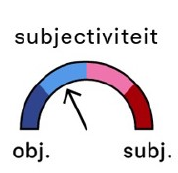back to list
 Social media posts from politicians are biased, i.e. strongly in favor of one group or argument, and framed, i.e. selected, emphasised and presented. Although bias and framing do not imply falsehood, they do shape the receiver’s understanding of information, as politicians typically choose the most salient perspective to communicate their arguments effectively. These biases and frames obfuscate the versatility of policy issues, particularly as they are featured in homogeneous and personalized interfaces of social media users, known as filter bubbles. Literature indicated that information visualization can potentially increase political bias awareness, and mitigate political framing effects [1, 44, 46, 57, 59]. However, studies to date have mainly focused on news articles or long text documents, for which reason their findings are hard to generalize to the social media domain, where information needs to be fitted in shorter pieces of text, and often include other types of multimedia (e.g., hyperlinks).
Social media posts from politicians are biased, i.e. strongly in favor of one group or argument, and framed, i.e. selected, emphasised and presented. Although bias and framing do not imply falsehood, they do shape the receiver’s understanding of information, as politicians typically choose the most salient perspective to communicate their arguments effectively. These biases and frames obfuscate the versatility of policy issues, particularly as they are featured in homogeneous and personalized interfaces of social media users, known as filter bubbles. Literature indicated that information visualization can potentially increase political bias awareness, and mitigate political framing effects [1, 44, 46, 57, 59]. However, studies to date have mainly focused on news articles or long text documents, for which reason their findings are hard to generalize to the social media domain, where information needs to be fitted in shorter pieces of text, and often include other types of multimedia (e.g., hyperlinks).
The current study aimed to bridge this knowledge gap, by validating the impact of information visualization in a simulated social media context, based on Twitter. The data consisted of microblogs (known as tweets) from politicians and news outlets. Three types of visualization methods, aimed at increasing political bias awareness and mitigation of framing effects, were designed: 1) a static, context-dependent visualization on tweet-level, 2) frame opposition between political and news tweets, and 3) an interactive dashboard visualization that displayed aggregate data over time. The visualizations were tested in a user study (N=21). The results on the impact of visualization type 1) showed that participants’ political bias awareness had increased. However, neither a mitigated framing effect was visible in the results on the impact of visualization type 2), nor the added value of visualization type 3). This report discusses the process and results of the current study, and concludes with suggestions for future research.
Project: Behind the Political Frame: Exploring Visualization Methods to Increase Bias Awareness and Mitigate Framing Effects on Social Media
Description
 Social media posts from politicians are biased, i.e. strongly in favor of one group or argument, and framed, i.e. selected, emphasised and presented. Although bias and framing do not imply falsehood, they do shape the receiver’s understanding of information, as politicians typically choose the most salient perspective to communicate their arguments effectively. These biases and frames obfuscate the versatility of policy issues, particularly as they are featured in homogeneous and personalized interfaces of social media users, known as filter bubbles. Literature indicated that information visualization can potentially increase political bias awareness, and mitigate political framing effects [1, 44, 46, 57, 59]. However, studies to date have mainly focused on news articles or long text documents, for which reason their findings are hard to generalize to the social media domain, where information needs to be fitted in shorter pieces of text, and often include other types of multimedia (e.g., hyperlinks).
Social media posts from politicians are biased, i.e. strongly in favor of one group or argument, and framed, i.e. selected, emphasised and presented. Although bias and framing do not imply falsehood, they do shape the receiver’s understanding of information, as politicians typically choose the most salient perspective to communicate their arguments effectively. These biases and frames obfuscate the versatility of policy issues, particularly as they are featured in homogeneous and personalized interfaces of social media users, known as filter bubbles. Literature indicated that information visualization can potentially increase political bias awareness, and mitigate political framing effects [1, 44, 46, 57, 59]. However, studies to date have mainly focused on news articles or long text documents, for which reason their findings are hard to generalize to the social media domain, where information needs to be fitted in shorter pieces of text, and often include other types of multimedia (e.g., hyperlinks).The current study aimed to bridge this knowledge gap, by validating the impact of information visualization in a simulated social media context, based on Twitter. The data consisted of microblogs (known as tweets) from politicians and news outlets. Three types of visualization methods, aimed at increasing political bias awareness and mitigation of framing effects, were designed: 1) a static, context-dependent visualization on tweet-level, 2) frame opposition between political and news tweets, and 3) an interactive dashboard visualization that displayed aggregate data over time. The visualizations were tested in a user study (N=21). The results on the impact of visualization type 1) showed that participants’ political bias awareness had increased. However, neither a mitigated framing effect was visible in the results on the impact of visualization type 2), nor the added value of visualization type 3). This report discusses the process and results of the current study, and concludes with suggestions for future research.
Details
- Student
-
WRWies Ruyters
- Supervisor
-
 Huub van de Wetering
Huub van de Wetering
- Link
- Thesis